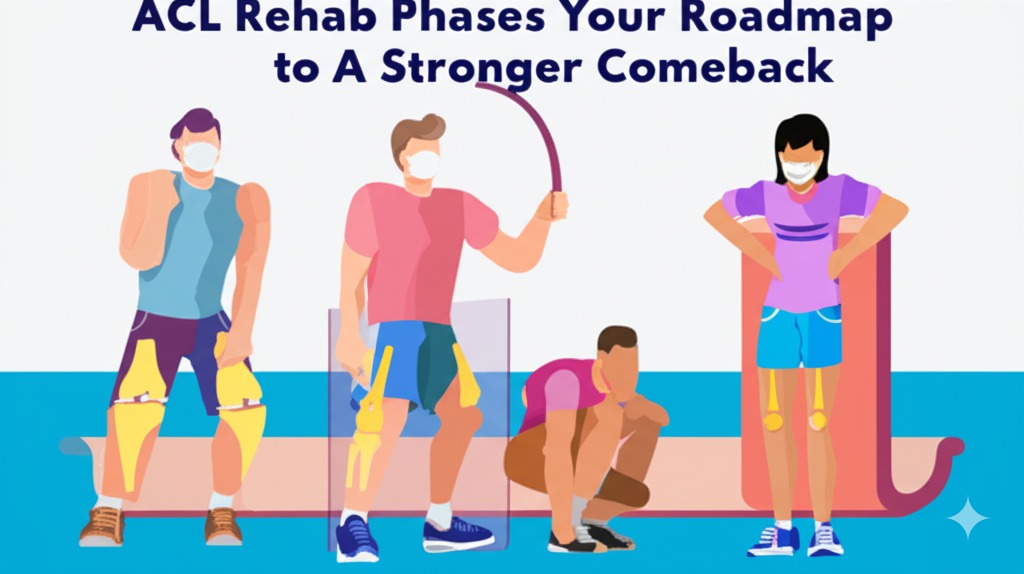An ACL (anterior cruciate ligament) injury can be a devastating setback—especially for athletes or active individuals. But the good news? With a clear and consistent ACL rehab plan, you can regain strength, stability, and confidence in your knee. Understanding the different phases of ACL rehabilitation is key to a full recovery and avoiding future injuries.
In this guide, we’ll walk you through the key phases of ACL rehab, what to expect in each stage, and tips to make the process smoother and more effective.
Phase 1: Prehabilitation – Laying the Foundation
Before surgery (if required), or in the early days post-injury, prehab is crucial. This phase helps reduce swelling, improve mobility, and prepare the knee for the road ahead.
Goals of Prehab
- Reduce pain and swelling
- Restore range of motion (ROM)
- Improve muscle activation, especially the quadriceps
- Educate the patient on post-op expectations
Key exercises:
- Heel slides
- Straight leg raises
- Quad sets
- Stationary cycling (as tolerated)
Pro Tip: The stronger and more mobile your knee is before surgery, the better your outcomes during rehab.
Phase 2: Early Post-Op Recovery (Weeks 1–3)
Once ACL reconstruction is done, it’s time to focus on healing and gentle movement. The first few weeks are critical for protecting the graft and preventing complications.
Primary Goals
- Protect the new ACL graft
- Control inflammation
- Achieve full knee extension
- Begin gentle flexion
- Normalize walking pattern (gait)
Common strategies:
- R.I.C.E. (Rest, Ice, Compression, Elevation)
- Using crutches and a brace
- Passive and active ROM exercises
- Ankle pumps to prevent blood clots
Avoid: Overloading the knee or aggressive bending in the early days.
Phase 3: Strength and Control (Weeks 3–6)
Once swelling is down and ROM improves, it’s time to rebuild strength and start neuromuscular re-education.
Key Objectives
- Increase muscle strength, especially quads, hamstrings, and glutes
- Enhance balance and coordination
- Improve weight-bearing ability
- Wean off crutches and brace
Recommended exercises:
- Mini squats
- Step-ups
- Leg presses (light resistance)
- Balance training (BOSU ball, single-leg stands)
Watch for: Pain or swelling after workouts—if it flares up, back off and reassess.
Phase 4: Functional Training (Weeks 7–12)
This is where the real transformation happens. You’ll work on dynamic movement patterns, agility, and sport-specific drills.
Focus Areas
- Improve endurance and agility
- Start plyometric exercises
- Incorporate low-impact cardiovascular training
- Return to non-contact sports drills
Examples of training:
- Lunges and side steps
- Skater hops
- Ladder drills
- Elliptical and pool running
Important: Progress gradually. Overdoing it can risk re-injury.
Phase 5: Return to Sport (Months 4–6+)
This final phase is tailored to your personal goals, whether it’s getting back on the field, court, or simply returning to pain-free activity.
Key Metrics Before Return to Sport
- Full ROM and strength symmetry with the uninjured leg
- Ability to perform single-leg hops and landings confidently
- Cleared by your surgeon and physical therapist
Final Prep Activities:
- Sprint drills
- Cutting and pivoting practice
- Reaction time exercises
- Functional testing (Y-balance, hop tests)
Note: Rushing back too soon is a top cause of ACL re-tears. Let your body—and data—guide your return.
Recovery Tips for Every Phase
Here are some universal ACL rehab tips to stay on track:
- Stay consistent with your rehab plan and appointments
- Listen to your body—don’t push through sharp pain or swelling
- Track your progress with journals or rehab apps
- Fuel your recovery with proper nutrition and hydration
- Focus on mental recovery too—working with a sports psychologist can help
Conclusion: Be Patient, Stay Committed
Rehabbing an ACL injury is a marathon, not a sprint. By following a structured rehab plan, progressing through each ACL rehab phase, and staying in tune with your body, you’ll build a knee that’s not just healed—but stronger than ever.

Kallie Snyder is an author at Stonegate Health Rehab, providing valuable insights, recovery guidance, and rehab resources to help individuals achieve better health and well-being.
